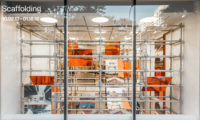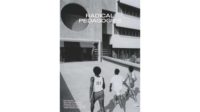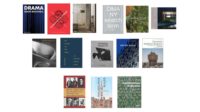Jennifer Bonner and Hanif Kara’s new book, Blank: Speculations on CLT, offers a combination of thought-provoking essays and speculative design projects to “reset” the conversation around CLT, or cross-laminated timber. A collaboration between Bonner, an architect, and Kara, an engineer, the book originated in a design studio at the Harvard Graduate School of Design, called “Mass Timber and the Scandinavian Effect,” that they co-taught in 2020.
Much of the current interest in mass timber has to do with its sustainability, as one of the only rapidly renewable materials capable of lowering the building industry’s carbon footprint. But, Bonner and Kara are quick to note, “we believe the CLT ‘blank’ can and must be conceptualized beyond its sustainability.” As a large-scale modular panel, the CLT blank offers structural capacity as well as a “ready-made” finish material, with the potential to affect both the embodied energy of buildings as well as their aesthetics. The book’s contributors see it as a material system with significant expressive potential, akin to the liberatory logics of Le Corbusier’s Maison Domino.
Chris Lee’s essay, “Essential Planes,” reads the potential of CLT’s planar logic against the frame logic of an earlier paradigm, as articulated in Colin Rowe’s essay “The Chicago Frame” and witnessed by the overall impact of the Maison Domino. Lee notes the decades-long “gestation” period between the Domino concept and the building industry’s adoption of the concrete frame, and speculates about a similar absorption rate for CLT to become mainstream.
In “Blank Shots: Monolithic Desires and Laminar Inevitabilities,” Nader Tehrani notes the fundamental rift between monolithic construction, of a traditional multi-wythe brick wall, and the laminar construction of a contemporary stud wall with sheathing, vapor barriers, cladding, and interior finishes. Tehrani sees the current interest in mass timber as a part of what he calls the “ethic of a mono-material” approach, and as a technique of reclaiming aspects of means and methods long ceded to the building industry.
Running in parallel to the essays, but rotated 90 degrees in the book layout (like the cross lamination in CLT), is a series of design projects produced by graduate students, beautifully drawn to highlight the modularity of the CLT blank. The 9-foot by 50-foot module appears in both plan and elevation drawings as a fundamental building block, out of which all designs are assembled. The emphasis in the architectural parts corresponds with the principles of aggregation and part-to-whole relationships. Many of the designs highlight the unit logic in the lapped corners of the blanks’ staggered edges. Elsewhere, strategies focus on the assembled nature of their construction-driven conception.
Returning to the editors’ initial claim to think of CLT’s impact beyond its sustainability, the arguments made in the book point to CLT’s expressive potential, its modular thinking and tendency to drive design decisions from construction-phase issues of sequence and logistics into the early conceptual-design phases of a project. Most mass timber is used to replace steel or concrete elements, substituting planar or axial members with their timber alternatives but not altering their configuration or conception. What is exciting about the essays and projects in this book is their desire to seek out the impacts on architecture beyond replacement. They ask, How could this expanded palette of materials and systems also expand the expressive and organizational logics for architecture?
Mies van der Rohe’s 1921 charcoal renderings of the Friedrichstrasse Tower provide a powerful image of a materially driven design for an all-glass tower, decades before such an envelope was technically achievable. Mies’s renderings present an anticipatory vision for a future that was just out of reach. The difference with the CLT projects presented in this book is that they are technically achievable today. The barriers to entry for this mass-timber future are not technical—the limits are regulatory, logistical, economic, and, frankly, imaginative. The authors of and contributors to Blank are calling for an acknowledgement of the moment—we are at the precipice of a paradigm shift that will reset the field. In his essay “Chicago Frame,” Rowe reads pairs of projects that employ the structural steel frame. In some he sees practical proposals that are primarily buildings, yet in others he sees a predominant polemic—in his words, “an advertisement for a cause.” Blank: Speculations on CLT is both a critique of business as usual and a rallying cry for a cause. It is a prod and a premonition of an alternative architecture driven by a material imagination, part pragmatism and part polemic. At this moment, we need both.





Post a comment to this article
Report Abusive Comment